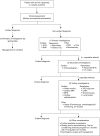Diagnostic approach to chronic dyspnoea in adults
- PMID: 31737340
- PMCID: PMC6831921
- DOI: 10.21037/jtd.2019.10.53
Diagnostic approach to chronic dyspnoea in adults
Abstract
Chronic dyspnoea, or breathlessness for more than four weeks duration, is a common symptom in adults presenting to primary and tertiary care. It often presents a diagnostic challenge due to the wide spectrum of underlying disease, which is multifactorial in approximately one third of cases. Challenges in diagnosis include an often non-diagnostic clinical assessment, difficulty in selecting the most appropriate investigations and correct speciality referral for further diagnostic assessment. In patients presenting with chronic dyspnoea, history and physical examination are often non-specific with key findings more useful as negative predictive factors. There is a broad range of simple to specialised investigations that may be utilised in the diagnostic workup. Several diagnostic algorithms incorporating different tiers of investigations have been tested in studies of chronic dyspnoea patients but there is currently very limited data that test a diagnostic algorithm against standard clinical care. In this review we propose a diagnostic pathway with primary, secondary and tertiary level investigations for patients with chronic dyspnoea. This pathway is based on the combination of previously tested diagnostic algorithms in the literature, to assist clinicians in their diagnostic workup of chronic dyspnoea patients. Further research is needed to further evaluate diagnostic algorithms in this setting and to test this diagnostic pathway in clinical practice.
Keywords: Dyspnoea; algorithm; breathlessness; diagnosis.
2019 Journal of Thoracic Disease. All rights reserved.
Conflict of interest statement
Conflicts of Interest: The authors have no conflicts of interest to declare.
Figures

References
-
- Karnani NG, Reisfield GM, Wilson GR. Evaluation of chronic dyspnea. Am Fam Physician 2005;71:1529-37. - PubMed
Publication types
LinkOut - more resources
Full Text Sources
